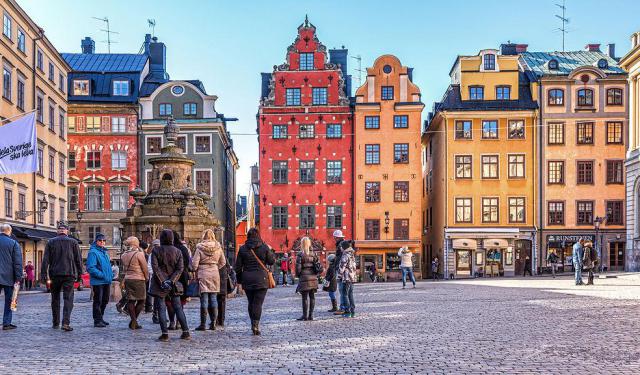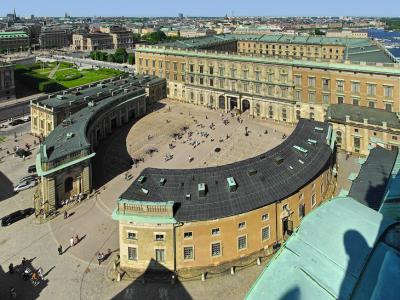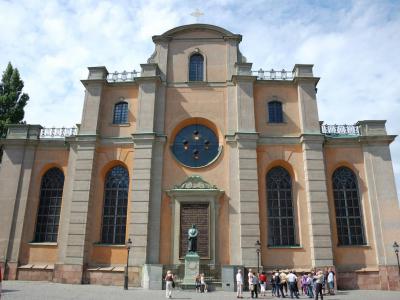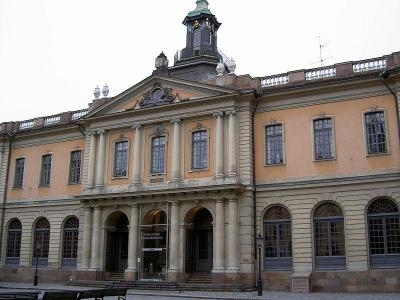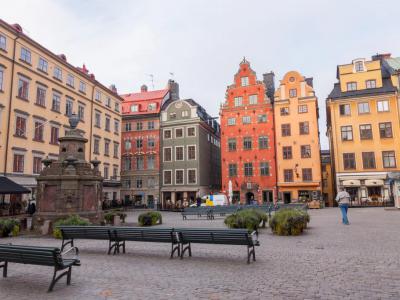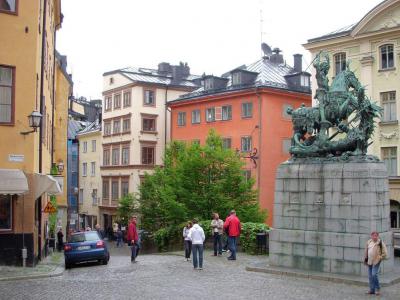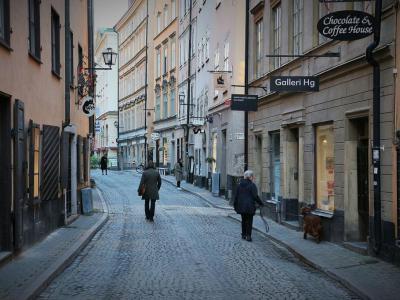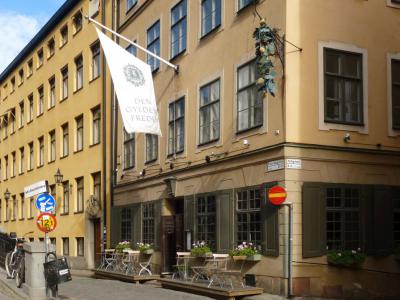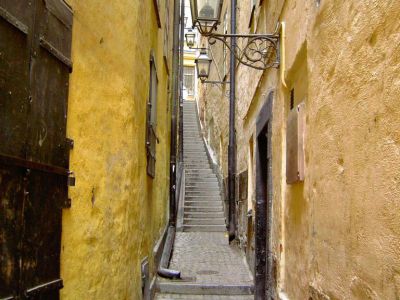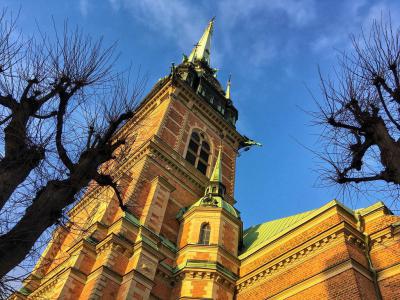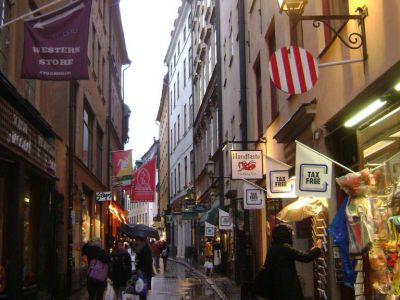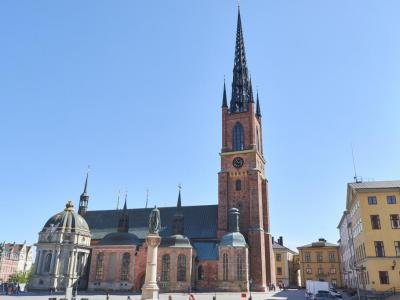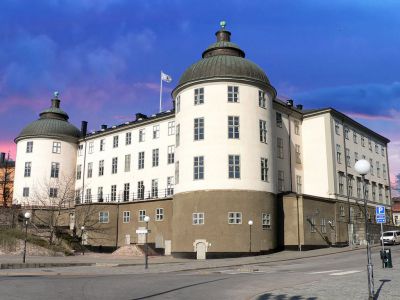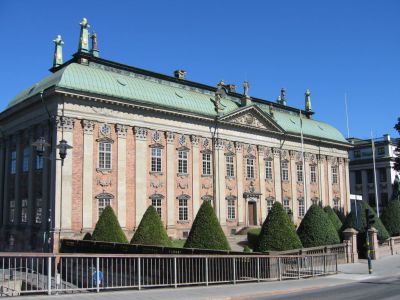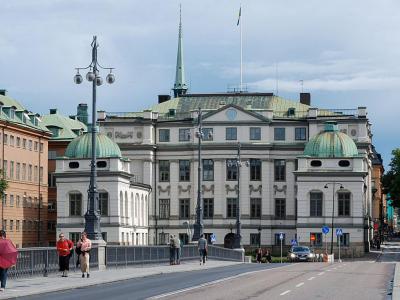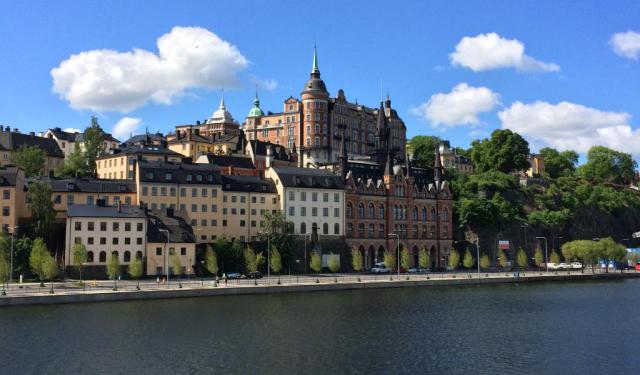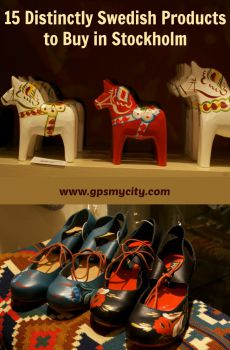Audio Guide: Old Town (Gamla Stan) Walking Tour (Self Guided), Stockholm
Stockholm, established around 1000 AD on an archipelago on the eastern coast of Sweden, flourished due to Viking-established trade routes. Originally a Viking site, it became a key iron trade hub by 1252. The city's name, derived from the Old Norse words for "log islet," reflects its historical significance, as a fortified island used for defense against sea invasions, and its strategic location.
Stockholm's core, the present Old Town (Gamla Stan), built on the archipelago's central island in the 13th century, rose to prominence through Baltic trade via the Hanseatic League, developing strong ties with key northern European cities. Influenced heavily by its German-speaking community, Stockholm's strategic significance influenced Swedish independence efforts, leading to the establishment of royal power under king Gustav Vasa in 1523.
In 1634, Stockholm was declared the capital of the Swedish Empire. In the late 18th century, during the Enlightenment, it saw significant economic and international gains, becoming a cultural hub with prominent figures like biologist Carl Linnaeus and physicist Anders Celsius spending time here.
In the early 19th century, Stockholm faced economic decline, but it rebounded by the late 1800s, regaining its economic prominence. The early 20th century marked the inception of the Nobel Prizes, enhancing the city's cultural stature. Despite modernist changes, many historical structures in Old Town, the historical heartbeat of Stockholm, survived, maintaining its essence in the modern, diverse cityscape of the late 20th century.
Known officially, before 1980, as “The Town Between Bridges”, Old Town is a maze of medieval alleyways, cobbled streets, and ochre-colored archaic buildings that seem to whisper tales of past times.
There are quite a few notable sights in this compact neighborhood, including – at its heart – the majestic Royal Palace, the official residence of the Swedish monarch.
Adjacent to the Royal Palace is the venerable Stockholm Cathedral, a prime example of Swedish Brick Gothic architecture. A short walk away, the Nobel Prize Museum celebrates the legacy of Alfred Nobel and the laureates who have followed in his footsteps, providing a deep dive into the worlds of science, literature, and peace.
Stortorget, the oldest square in Stockholm, serves as the scenic setting for much of the city's historical narrative.
To truly experience the essence of Stockholm, one must wander through its historical corridors, from regal palaces to sacred churches, each telling a unique story of a city that has beautifully melded its past with the present. To explore the delights of Stockholm's Old Town in more detail and experience the way it used to be in the old days, follow this self-guided walk!
Stockholm's core, the present Old Town (Gamla Stan), built on the archipelago's central island in the 13th century, rose to prominence through Baltic trade via the Hanseatic League, developing strong ties with key northern European cities. Influenced heavily by its German-speaking community, Stockholm's strategic significance influenced Swedish independence efforts, leading to the establishment of royal power under king Gustav Vasa in 1523.
In 1634, Stockholm was declared the capital of the Swedish Empire. In the late 18th century, during the Enlightenment, it saw significant economic and international gains, becoming a cultural hub with prominent figures like biologist Carl Linnaeus and physicist Anders Celsius spending time here.
In the early 19th century, Stockholm faced economic decline, but it rebounded by the late 1800s, regaining its economic prominence. The early 20th century marked the inception of the Nobel Prizes, enhancing the city's cultural stature. Despite modernist changes, many historical structures in Old Town, the historical heartbeat of Stockholm, survived, maintaining its essence in the modern, diverse cityscape of the late 20th century.
Known officially, before 1980, as “The Town Between Bridges”, Old Town is a maze of medieval alleyways, cobbled streets, and ochre-colored archaic buildings that seem to whisper tales of past times.
There are quite a few notable sights in this compact neighborhood, including – at its heart – the majestic Royal Palace, the official residence of the Swedish monarch.
Adjacent to the Royal Palace is the venerable Stockholm Cathedral, a prime example of Swedish Brick Gothic architecture. A short walk away, the Nobel Prize Museum celebrates the legacy of Alfred Nobel and the laureates who have followed in his footsteps, providing a deep dive into the worlds of science, literature, and peace.
Stortorget, the oldest square in Stockholm, serves as the scenic setting for much of the city's historical narrative.
To truly experience the essence of Stockholm, one must wander through its historical corridors, from regal palaces to sacred churches, each telling a unique story of a city that has beautifully melded its past with the present. To explore the delights of Stockholm's Old Town in more detail and experience the way it used to be in the old days, follow this self-guided walk!
How it works: Download the app "GPSmyCity: Walks in 1K+ Cities" from Apple App Store or Google Play Store to your mobile phone or tablet. The app turns your mobile device into a personal tour guide and its built-in GPS navigation functions guide you from one tour stop to next. The app works offline, so no data plan is needed when traveling abroad.
Old Town (Gamla Stan) Walking Tour Map
Guide Name: Old Town (Gamla Stan) Walking Tour
Guide Location: Sweden » Stockholm (See other walking tours in Stockholm)
Guide Type: Self-guided Walking Tour (Sightseeing)
# of Attractions: 14
Tour Duration: 2 Hour(s)
Travel Distance: 2.1 Km or 1.3 Miles
Author: Daniel
Sight(s) Featured in This Guide:
Guide Location: Sweden » Stockholm (See other walking tours in Stockholm)
Guide Type: Self-guided Walking Tour (Sightseeing)
# of Attractions: 14
Tour Duration: 2 Hour(s)
Travel Distance: 2.1 Km or 1.3 Miles
Author: Daniel
Sight(s) Featured in This Guide:
- Royal Palace
- Stockholm Cathedral
- Nobel Prize Museum
- Stortorget (Grand Square)
- Köpmanbrinken (Merchant's Slope)
- Österlånggatan (Eastern Long Street)
- Den Gyldene Freden (The Golden Peace) Restaurant
- Marten Trotzigs Grand (Marten Trotzig's Alley)
- German Church
- Västerlånggatan (Western Long Street)
- Riddarholmen Church
- Wrangel Palace
- Riddarhuset (House of Nobility)
- Bonde Palace
1) Royal Palace (must see)
The Royal Palace in Stockholm, also known as Stockholm Palace, is the official residence of the Swedish monarch, although King Carl XVI Gustaf and Queen Silvia primarily reside at Drottningholm Palace. Situated in the Old Town of Stockholm (Gamla Stan), adjacent to the Parliament building, the Royal Palace is a significant ceremonial venue for the King in his role as head of state.
This historic site has served as a royal residence since the mid-13th century, originally home to the Three Crowns (Tre Kronor) Castle. Following a devastating fire in 1697, the current palace was constructed, with its completion delayed until 1754 due to the Great Northern War. The palace is one of the largest in the world, boasting over 1,400 rooms, including state and guest apartments, the Hall of State, the Royal Chapel, and several museums.
Visitors are welcomed by the Swedish Royal Guard, a tradition rooted in medieval Sweden, adding to the palace's majestic atmosphere. The palace’s interior is notable for its exquisite copper roof and houses significant cultural artifacts, including the Bernadotte Library, the Royal Armoury, and the Three Crowns Museum.
One of the most distinguished features is Gustav III's Museum of Antiquities, one of Europe’s oldest museums, which displays over 200 sculptures acquired by King Gustav III during his travels in Italy. The palace also offers a unique shopping experience at the Royal Gift Shop, where visitors can purchase exclusive items linked to the Royal Collections. The shop is open daily with free entry, making it a popular destination for both history enthusiasts and those seeking distinctive souvenirs.
Tip:
While the rooms are well-marked in English, it's always good to go on a guided tour for a more personalized experience.
The Treasury room, with all the regalia, would justify taking the tour as you get to learn more about what you're looking at.
This historic site has served as a royal residence since the mid-13th century, originally home to the Three Crowns (Tre Kronor) Castle. Following a devastating fire in 1697, the current palace was constructed, with its completion delayed until 1754 due to the Great Northern War. The palace is one of the largest in the world, boasting over 1,400 rooms, including state and guest apartments, the Hall of State, the Royal Chapel, and several museums.
Visitors are welcomed by the Swedish Royal Guard, a tradition rooted in medieval Sweden, adding to the palace's majestic atmosphere. The palace’s interior is notable for its exquisite copper roof and houses significant cultural artifacts, including the Bernadotte Library, the Royal Armoury, and the Three Crowns Museum.
One of the most distinguished features is Gustav III's Museum of Antiquities, one of Europe’s oldest museums, which displays over 200 sculptures acquired by King Gustav III during his travels in Italy. The palace also offers a unique shopping experience at the Royal Gift Shop, where visitors can purchase exclusive items linked to the Royal Collections. The shop is open daily with free entry, making it a popular destination for both history enthusiasts and those seeking distinctive souvenirs.
Tip:
While the rooms are well-marked in English, it's always good to go on a guided tour for a more personalized experience.
The Treasury room, with all the regalia, would justify taking the tour as you get to learn more about what you're looking at.
2) Stockholm Cathedral (must see)
Stockholm Cathedral, also known as the Church of Saint Nicholas (Sankt Nikolai Kyrka), is the oldest and one of the most historically significant temples in Stockholm. Centrally located at the highest point of Old Town (Gamla Stan), it is flanked by the Stock Exchange Building and Stockholm Palace, forming an integral part of the city's Baroque architectural landscape.
The cathedral was consecrated in 1306, with its origins dating back to the 13th century. It features a late medieval hall interior, while the exterior showcases Baroque modifications added in the 18th century. As a crucial site during the Reformation, Stockholm Cathedral hosted the first Mass in the Swedish language. Since 1942, it has served as the seat of the Bishop of Stockholm, highlighting its ongoing religious importance.
The cathedral has a deep historical connection with the Swedish royal family, having served as the city's sole parish church for many centuries. It has been the venue for royal coronations and other significant ceremonies, including the wedding of Crown Princess Victoria in 2010. The cathedral continues to play a vital role in national events and memorials, such as the funeral of renowned Swedish author Astrid Lindgren.
Inside, the cathedral houses several significant artworks, including a medieval sculpture of Saint George and the Dragon and the Vädersolstavlan painting, one of the earliest depictions of Stockholm. The surrounding area of the cathedral is rich with historical courtyards and statues, including representations of Reason, Divine Love, Caution, and Hope. Additionally, a statue of Olaus Petri, a key figure in the Swedish Reformation, stands near the church's east facade, where the pavement also marks the former extent of a church choir demolished during the reign of King Gustav Vasa in the 16th century.
Why You Should Visit:
Architecturally interesting, culturally enriching, and very peaceful.
Tip:
Check for free organ recitals (usually at noon) and other events.
Make sure to pick up a brochure as it is very helpful in explaining several main focuses within the cathedral.
The cathedral was consecrated in 1306, with its origins dating back to the 13th century. It features a late medieval hall interior, while the exterior showcases Baroque modifications added in the 18th century. As a crucial site during the Reformation, Stockholm Cathedral hosted the first Mass in the Swedish language. Since 1942, it has served as the seat of the Bishop of Stockholm, highlighting its ongoing religious importance.
The cathedral has a deep historical connection with the Swedish royal family, having served as the city's sole parish church for many centuries. It has been the venue for royal coronations and other significant ceremonies, including the wedding of Crown Princess Victoria in 2010. The cathedral continues to play a vital role in national events and memorials, such as the funeral of renowned Swedish author Astrid Lindgren.
Inside, the cathedral houses several significant artworks, including a medieval sculpture of Saint George and the Dragon and the Vädersolstavlan painting, one of the earliest depictions of Stockholm. The surrounding area of the cathedral is rich with historical courtyards and statues, including representations of Reason, Divine Love, Caution, and Hope. Additionally, a statue of Olaus Petri, a key figure in the Swedish Reformation, stands near the church's east facade, where the pavement also marks the former extent of a church choir demolished during the reign of King Gustav Vasa in the 16th century.
Why You Should Visit:
Architecturally interesting, culturally enriching, and very peaceful.
Tip:
Check for free organ recitals (usually at noon) and other events.
Make sure to pick up a brochure as it is very helpful in explaining several main focuses within the cathedral.
3) Nobel Prize Museum (must see)
The Nobel Prize Museum in Stockholm is a must-visit destination for anyone interested in the legacy of Alfred Nobel, the Nobel Prize, and its distinguished laureates. Opened in 2001 to commemorate the centenary of the Nobel Prize, the museum offers an immersive experience into the world of this prestigious award.
The museum’s permanent exhibition showcases a fascinating collection of artifacts, personal stories, and historical accounts from Nobel Prize winners dating back to 1901. Visitors can learn about the lives and contributions of iconic figures such as Marie Curie, Nelson Mandela, and Winston Churchill.
One of the museum's highlights is the "Cultures of Creativity Exhibit," which guides visitors through the intricate process of selecting a Nobel Prize winner, culminating in the grandeur of the Nobel Banquet. An integral part of this experience is the Nobel ice cream, a treat traditionally served at the annual awards ceremony, which visitors can sample during their visit.
The museum offers daily multilingual tours, including in English, and hosts a variety of public events, conferences, and workshops. These activities are designed to engage and educate visitors, making the museum a dynamic hub of learning and inspiration.
For those wishing to take home a unique souvenir, the museum's shop offers a range of exclusive items, such as dark fair-trade chocolate versions of Alfred Nobel's gold medal and Swedish “dynamite” candy flavored with jalapeño pepper. The shop also features educational toys, books by and about Nobel laureates, and other distinctive keepsakes.
Visitors can also enjoy a meal at Bistro Nobel, which serves a selection of Swedish cakes, Nobel chocolate, and the famous Nobel ice cream and tea-both of which are featured at the Nobel Banquet. The bistro provides a perfect spot to relax and reflect on the museum's inspiring exhibits while enjoying traditional Swedish cuisine.
Tip:
Join the English tour to get the most out of your visit.
The museum’s permanent exhibition showcases a fascinating collection of artifacts, personal stories, and historical accounts from Nobel Prize winners dating back to 1901. Visitors can learn about the lives and contributions of iconic figures such as Marie Curie, Nelson Mandela, and Winston Churchill.
One of the museum's highlights is the "Cultures of Creativity Exhibit," which guides visitors through the intricate process of selecting a Nobel Prize winner, culminating in the grandeur of the Nobel Banquet. An integral part of this experience is the Nobel ice cream, a treat traditionally served at the annual awards ceremony, which visitors can sample during their visit.
The museum offers daily multilingual tours, including in English, and hosts a variety of public events, conferences, and workshops. These activities are designed to engage and educate visitors, making the museum a dynamic hub of learning and inspiration.
For those wishing to take home a unique souvenir, the museum's shop offers a range of exclusive items, such as dark fair-trade chocolate versions of Alfred Nobel's gold medal and Swedish “dynamite” candy flavored with jalapeño pepper. The shop also features educational toys, books by and about Nobel laureates, and other distinctive keepsakes.
Visitors can also enjoy a meal at Bistro Nobel, which serves a selection of Swedish cakes, Nobel chocolate, and the famous Nobel ice cream and tea-both of which are featured at the Nobel Banquet. The bistro provides a perfect spot to relax and reflect on the museum's inspiring exhibits while enjoying traditional Swedish cuisine.
Tip:
Join the English tour to get the most out of your visit.
4) Stortorget (Grand Square) (must see)
Contrary to its name, Stockholm's "Grand Square" (Stortorget) was never a stylish showpiece unlike the ones in many other European cities during the Middle Ages. It was created gradually, with the surrounding buildings added haphazardly throughout the years.
Nowadays, this is the city's oldest square and an artistic and shopping hub, particularly renowned for its annual Christmas market with fun shows, traditional handicrafts, and sumptuous culinary delights.
It is also the location of the Stock Exchange Building (Börshuset) – home to the Swedish Academy, the Nobel Museum, and the Nobel Library – built in 1773 through 1776. The nearby well dried up in 1856 due to land elevation. It was then relocated to another square (Brunkebergstorg) but eventually moved back to its original location in the 1950s, and has been connected to the city water conduit ever since.
Grand Square sits at the highest point in Stockholm and presents a carefully restored rendition of the historical buildings. Among them is house No. 3 constructed in the 1640s, commonly known as Grill House (Grillska Huset), named after its owner, Antoni Grill. The nearby building No. 5 was also Grill's property. The buildings at numbers 18 and 20 were merged into one in the 17th century and named for Johan Eberhard Schantz, the secretary of King Charles X Gustavus. House No. 22, on the left side of the square, once occupied by one of the closest friends of King Charles XI, was built in 1758 and is easily identified by its green color.
The square had a violent history, ill-famed as the location of the Stockholm Bloodbath, which took place in 1520 and resulted in the beheadings of over 80 noblemen. Their bodies were left there to bleed out, leaving pools of blood running throughout the town. Eww...(((
Indeed, the antique cobblestones of Grand Square make you feel like stepping back into the times of Old Sweden, with the pastel buildings mimicking the colors commonplace in those days.
Why You Should Visit:
The Old Town is by far the most picturesque area in Stockholm, and while this square seems unpretentious at first sight, it has a unique ambiance.
Tip:
Make sure to stand in the middle and look all around you.
Nowadays, this is the city's oldest square and an artistic and shopping hub, particularly renowned for its annual Christmas market with fun shows, traditional handicrafts, and sumptuous culinary delights.
It is also the location of the Stock Exchange Building (Börshuset) – home to the Swedish Academy, the Nobel Museum, and the Nobel Library – built in 1773 through 1776. The nearby well dried up in 1856 due to land elevation. It was then relocated to another square (Brunkebergstorg) but eventually moved back to its original location in the 1950s, and has been connected to the city water conduit ever since.
Grand Square sits at the highest point in Stockholm and presents a carefully restored rendition of the historical buildings. Among them is house No. 3 constructed in the 1640s, commonly known as Grill House (Grillska Huset), named after its owner, Antoni Grill. The nearby building No. 5 was also Grill's property. The buildings at numbers 18 and 20 were merged into one in the 17th century and named for Johan Eberhard Schantz, the secretary of King Charles X Gustavus. House No. 22, on the left side of the square, once occupied by one of the closest friends of King Charles XI, was built in 1758 and is easily identified by its green color.
The square had a violent history, ill-famed as the location of the Stockholm Bloodbath, which took place in 1520 and resulted in the beheadings of over 80 noblemen. Their bodies were left there to bleed out, leaving pools of blood running throughout the town. Eww...(((
Indeed, the antique cobblestones of Grand Square make you feel like stepping back into the times of Old Sweden, with the pastel buildings mimicking the colors commonplace in those days.
Why You Should Visit:
The Old Town is by far the most picturesque area in Stockholm, and while this square seems unpretentious at first sight, it has a unique ambiance.
Tip:
Make sure to stand in the middle and look all around you.
5) Köpmanbrinken (Merchant's Slope)
Merchant's Slope (Köpmanbrinken) is a historic street located in Stockholm's Old Town (Gamla Stan). This street is unique as it consists of two distinct slopes that were unified under the current name in 1885, following the creation of Merchant's Square (Köpmantorget) which separates them.
The northern slope of Merchant's Slope has a rich history, once known as Fishing Shore Slope (Fiskestrandsbrinken), due to its proximity to the city's primary fish market during the Middle Ages, from 1413 to 1520. This market, located to the east of the slope, played a crucial role in the city's daily life, highlighting the area's importance as a bustling center of commerce.
As you walk along Merchant's Slope, one of the most striking features is the statue of Saint George and the Dragon. This bronze replica, cast in 1912, is a copy of the original medieval sculpture housed in Stockholm Cathedral. The statue depicts a young Saint George, dressed in full battle armor, valiantly fighting a dragon. While the replica stays true to the spirit of the original from 1489, it introduces several alterations, such as modifications to the knight's helmet and the dragon's position. The statue is mounted on a plinth adorned with reliefs depicting the martyrdom of Saint George, adding to its historical and artistic significance.
Number 17 Köpmanbrinken stands out for its early 20th-century design, completed in 1902. The building accommodates a mix of ground-floor shops, office spaces, and residences. It also houses the restaurant "Pontus in the Green House," which adds a modern touch with its distinctive color scheme. Flanking this building are two alleys with historical significance: Nygränd (New Alley) and Brunnsgränd (Well's Alley). Although Brunnsgränd suggests the presence of a well, none exists, adding a bit of historical curiosity to the area.
The northern slope of Merchant's Slope has a rich history, once known as Fishing Shore Slope (Fiskestrandsbrinken), due to its proximity to the city's primary fish market during the Middle Ages, from 1413 to 1520. This market, located to the east of the slope, played a crucial role in the city's daily life, highlighting the area's importance as a bustling center of commerce.
As you walk along Merchant's Slope, one of the most striking features is the statue of Saint George and the Dragon. This bronze replica, cast in 1912, is a copy of the original medieval sculpture housed in Stockholm Cathedral. The statue depicts a young Saint George, dressed in full battle armor, valiantly fighting a dragon. While the replica stays true to the spirit of the original from 1489, it introduces several alterations, such as modifications to the knight's helmet and the dragon's position. The statue is mounted on a plinth adorned with reliefs depicting the martyrdom of Saint George, adding to its historical and artistic significance.
Number 17 Köpmanbrinken stands out for its early 20th-century design, completed in 1902. The building accommodates a mix of ground-floor shops, office spaces, and residences. It also houses the restaurant "Pontus in the Green House," which adds a modern touch with its distinctive color scheme. Flanking this building are two alleys with historical significance: Nygränd (New Alley) and Brunnsgränd (Well's Alley). Although Brunnsgränd suggests the presence of a well, none exists, adding a bit of historical curiosity to the area.
6) Österlånggatan (Eastern Long Street)
Eastern Long Street (Österlånggatan) is a historic thoroughfare located in the Old Town (Gamla Stan) of Stockholm. Its origins trace back to the 13th century when it served as a pathway along the eastern shoreline just outside the city's original walls. Over the centuries, significant changes transformed this street from a coastal road into a central artery of urban life, as land reclamation projects pushed the shoreline further eastward. This evolution turned Eastern Long Street into a bustling area lined with workshops, stores, and residences.
During the 17th century, the street became famous for its numerous taverns, which were particularly popular among the business crowd of the time. Of these taverns, only "The Golden Peace" (Den Gyldene Freden) at Number 51 remains today. Established in 1722, it holds a place in the Guinness Book of Records as one of the oldest restaurants with its interior largely unchanged since its founding. Despite its now peaceful and charming ambiance, Den Gyldene Freden's history is steeped in the rough and tumultuous life of the area, which was once notorious for its filth, stench, and frequent brawls.
As the centuries progressed, the street's connection to the shipping trade dwindled, and by the early 20th century, nearly all maritime-related activities had vanished. Today, Eastern Long Street is much quieter than in its bustling past, yet it still retains a significant amount of its historical charm.
Notable landmarks along the street include the Royal Coin Cabinet, which houses a collection of coins dating back to the 16th century, the Stockholm Concert Hall, and the Stockholm School of Economics. Additionally, Skipper Karl Alley (Skeppar Karls Gränd), named after a 16th-century skipper, serves as a reminder of the street's maritime heritage. Despite the passage of time and the changes that have occurred, Eastern Long Street remains a fascinating blend of history and modernity, offering a unique glimpse into Stockholm's rich past.
During the 17th century, the street became famous for its numerous taverns, which were particularly popular among the business crowd of the time. Of these taverns, only "The Golden Peace" (Den Gyldene Freden) at Number 51 remains today. Established in 1722, it holds a place in the Guinness Book of Records as one of the oldest restaurants with its interior largely unchanged since its founding. Despite its now peaceful and charming ambiance, Den Gyldene Freden's history is steeped in the rough and tumultuous life of the area, which was once notorious for its filth, stench, and frequent brawls.
As the centuries progressed, the street's connection to the shipping trade dwindled, and by the early 20th century, nearly all maritime-related activities had vanished. Today, Eastern Long Street is much quieter than in its bustling past, yet it still retains a significant amount of its historical charm.
Notable landmarks along the street include the Royal Coin Cabinet, which houses a collection of coins dating back to the 16th century, the Stockholm Concert Hall, and the Stockholm School of Economics. Additionally, Skipper Karl Alley (Skeppar Karls Gränd), named after a 16th-century skipper, serves as a reminder of the street's maritime heritage. Despite the passage of time and the changes that have occurred, Eastern Long Street remains a fascinating blend of history and modernity, offering a unique glimpse into Stockholm's rich past.
7) Den Gyldene Freden (The Golden Peace) Restaurant
The Golden Peace (Den Gyldene Freden), often affectionately referred to as "The Peace" by locals, is a renowned restaurant in Stockholm. Its name commemorates the Treaty of Nystad, which ended the Great Northern War between Russia and Sweden in 1721. This treaty resulted in Russia acquiring significant Swedish territories in the Baltics, but Sweden retained the larger territory of Finland, thus the "Golden" part of the name symbolizing this significant retention.
Established in 1722, Den Gyldene Freden holds the distinction of being the second oldest restaurant in the world to have preserved its original interior, making it a rare and authentic example of an 18th-century tavern. This historical significance has earned it a place in the Guinness Book of Records.
Over the centuries, Den Gyldene Freden has been a central hub for Sweden's cultural and literary figures, serving as a gathering spot for many renowned authors, painters, and songwriters. The restaurant initially gained fame through the songs of Carl Michael Bellman, an 18th-century national poet, and later through the works of 20th-century singer-songwriter Cornelis Vreeswijk.
Since 1901, the restaurant has been closely associated with the Nobel Prize in Literature. Each October, the Swedish Academy convenes at Golden Peace to announce the Nobel laureate in literature, further cementing the restaurant's place in Sweden's cultural and literary history.
Established in 1722, Den Gyldene Freden holds the distinction of being the second oldest restaurant in the world to have preserved its original interior, making it a rare and authentic example of an 18th-century tavern. This historical significance has earned it a place in the Guinness Book of Records.
Over the centuries, Den Gyldene Freden has been a central hub for Sweden's cultural and literary figures, serving as a gathering spot for many renowned authors, painters, and songwriters. The restaurant initially gained fame through the songs of Carl Michael Bellman, an 18th-century national poet, and later through the works of 20th-century singer-songwriter Cornelis Vreeswijk.
Since 1901, the restaurant has been closely associated with the Nobel Prize in Literature. Each October, the Swedish Academy convenes at Golden Peace to announce the Nobel laureate in literature, further cementing the restaurant's place in Sweden's cultural and literary history.
8) Marten Trotzigs Grand (Marten Trotzig's Alley)
Marten Trotzig's Alley is a unique and historical street located in the heart of Stockholm's Old Town, Gamla Stan. This area is renowned for its charming, centuries-old buildings and labyrinthine streets that have stood the test of time. Mårten Trotzigs Alley is particularly notable for being the narrowest street in Stockholm, a characteristic that has made it a popular attraction for both locals and tourists.
The alleyway is so narrow that at its tightest point, it measures only 35 inches (about 90 centimeters) wide, barely allowing enough space for a person to pass through without brushing against the walls. This cramped passage is not just a walkway; it also includes a steep staircase that connects two of the main roads in Gamla Stan. The street is adorned with a few modest lamps hanging from the walls, adding to its quaint and historical atmosphere.
The name of the alley pays homage to Mårten Trotzig, a wealthy German merchant who settled in Stockholm during the 16th century. Trotzig amassed his fortune by trading in iron and copper, becoming one of the city's wealthiest citizens. He eventually purchased the land surrounding the alleyway and set up a shop there. Although the alley did not originally have a name, it quickly became associated with Trotzig, and thus it has carried his name ever since.
Mårten Trotzigs Alley remains a fascinating piece of Stockholm's history, offering a glimpse into the city's past and the daily life of its earlier inhabitants. Despite its narrowness, or perhaps because of it, the alley continues to captivate visitors who come to experience this small but significant piece of Gamla Stan.
The alleyway is so narrow that at its tightest point, it measures only 35 inches (about 90 centimeters) wide, barely allowing enough space for a person to pass through without brushing against the walls. This cramped passage is not just a walkway; it also includes a steep staircase that connects two of the main roads in Gamla Stan. The street is adorned with a few modest lamps hanging from the walls, adding to its quaint and historical atmosphere.
The name of the alley pays homage to Mårten Trotzig, a wealthy German merchant who settled in Stockholm during the 16th century. Trotzig amassed his fortune by trading in iron and copper, becoming one of the city's wealthiest citizens. He eventually purchased the land surrounding the alleyway and set up a shop there. Although the alley did not originally have a name, it quickly became associated with Trotzig, and thus it has carried his name ever since.
Mårten Trotzigs Alley remains a fascinating piece of Stockholm's history, offering a glimpse into the city's past and the daily life of its earlier inhabitants. Despite its narrowness, or perhaps because of it, the alley continues to captivate visitors who come to experience this small but significant piece of Gamla Stan.
9) German Church
The German Church (Tyska kyrkan), also known as Saint Gertrude's Church (Sankta Gertruds Kyrka), is a significant historic and cultural landmark in Stockholm. Established in the 1580s, it has served as the primary place of worship for the German-speaking community in Stockholm for over four centuries. Initially, the church was shared with Finnish parishioners, but it became exclusively a German ecclesiastical site in 1607. Since then, the church's carillon has filled the air of the Old Town with psalms each day, a tradition that continues to this day.
The church is particularly noted for its striking architecture. Its 96-meter steeple, completed in 1878, features a distinctive brick and copper design, crowned by Neo-Gothic gargoyles-an unusual but now iconic element in Swedish architecture. The southern portal is adorned with sandstone statues of Jesus and Moses, representing the New and Old Testaments, flanked by figures symbolizing Love, Hope, and Faith, crafted in the 1640s.
Inside, the church boasts a richly Baroque style. Large windows flood the white-vaulted interior with light, highlighting the angelic motifs adorning the ceiling. The marble flooring conceals the remnants of the original guild building's wine cellars, linking the church to its historical roots. A standout feature is the ten-meter Baroque altar, which commands attention within the sanctuary. The atrium’s stained-glass window, depicting Saint Gertrude holding a chalice and a church model, is another prominent feature, adding to the church's sacred atmosphere.
One of the church's most historically significant features is the "King's Gallery." This gallery, which includes a sacristy and overlooks painted windows from the early 20th century, is decorated with the monogram of King Charles XI and features a magnificent staircase and a painted ceiling, reflecting the church's deep connections to German history.
Beyond its architectural and historical significance, the German Church continues to serve as a cultural hub for Stockholm's German-speaking community, hosting regular services and preserving the traditions of its congregation. Its long-standing musical contributions further underscore its role as a cultural cornerstone in Stockholm.
Tip:
Check the schedule – you may be able to catch a musical performance.
Visitors can hear the carillon every day, at 8 am and 4 pm.
If timing allows, you may see the inside with good lighting and be treated to the spectacular stained glass scenes.
The church is particularly noted for its striking architecture. Its 96-meter steeple, completed in 1878, features a distinctive brick and copper design, crowned by Neo-Gothic gargoyles-an unusual but now iconic element in Swedish architecture. The southern portal is adorned with sandstone statues of Jesus and Moses, representing the New and Old Testaments, flanked by figures symbolizing Love, Hope, and Faith, crafted in the 1640s.
Inside, the church boasts a richly Baroque style. Large windows flood the white-vaulted interior with light, highlighting the angelic motifs adorning the ceiling. The marble flooring conceals the remnants of the original guild building's wine cellars, linking the church to its historical roots. A standout feature is the ten-meter Baroque altar, which commands attention within the sanctuary. The atrium’s stained-glass window, depicting Saint Gertrude holding a chalice and a church model, is another prominent feature, adding to the church's sacred atmosphere.
One of the church's most historically significant features is the "King's Gallery." This gallery, which includes a sacristy and overlooks painted windows from the early 20th century, is decorated with the monogram of King Charles XI and features a magnificent staircase and a painted ceiling, reflecting the church's deep connections to German history.
Beyond its architectural and historical significance, the German Church continues to serve as a cultural hub for Stockholm's German-speaking community, hosting regular services and preserving the traditions of its congregation. Its long-standing musical contributions further underscore its role as a cultural cornerstone in Stockholm.
Tip:
Check the schedule – you may be able to catch a musical performance.
Visitors can hear the carillon every day, at 8 am and 4 pm.
If timing allows, you may see the inside with good lighting and be treated to the spectacular stained glass scenes.
10) Västerlånggatan (Western Long Street)
Western Long Street (Västerlånggatan) is one of the most iconic and vibrant thoroughfares in Stockholm's Old Town (Gamla Stan). A bustling hub for tourists, the street's historical significance and picturesque charm make it a must-visit destination.
Historically, Western Long Street was part of a larger road known as "The Common Street" or "The Long Street," which connected both the western and eastern sides of the city, extending beyond the medieval city walls. Its current name was officially adopted in 1885, distinguishing it from its counterpart, Österlånggatan (Eastern Long Street).
In its earliest days, Western Long Street was a simple pathway tracing the shoreline, linking the northern and southern city gates. By the 15th century, it had evolved into a bustling, paved street, lined with homes and shops. The street played a vital role in the city's economic life, first hosting blacksmiths' and coppersmiths' workshops, which were pushed outside the city limits due to the risk of fire. Later, in the 17th century, goldsmiths established themselves here, bringing a touch of prestige to the area.
The 19th century saw significant transformations along Western Long Street. Medieval facades were modernized with plaster ornaments and imported cast iron colonettes, reflecting contemporary tastes. Large shop windows began to appear, showcasing lavish interiors and drawing the attention of passersby.
In the latter half of the 20th century, Western Long Street underwent further changes, as part of a broader revitalization effort. The arrival of hotels, upscale businesses, and restaurants replaced many of the older shops. These new establishments catered to the growing number of tourists, shifting the street's character but also ensuring its continued vibrancy.
Today, Western Long Street remains a lively blend of the old and new. It is a place where shoppers explore boutiques, pub-goers add to the street's boisterous atmosphere, and musicians provide a soundtrack to the daily life of both locals and visitors. Despite its evolution, the street has managed to retain its historic charm and continues to be a vital part of Stockholm's cultural fabric.
Historically, Western Long Street was part of a larger road known as "The Common Street" or "The Long Street," which connected both the western and eastern sides of the city, extending beyond the medieval city walls. Its current name was officially adopted in 1885, distinguishing it from its counterpart, Österlånggatan (Eastern Long Street).
In its earliest days, Western Long Street was a simple pathway tracing the shoreline, linking the northern and southern city gates. By the 15th century, it had evolved into a bustling, paved street, lined with homes and shops. The street played a vital role in the city's economic life, first hosting blacksmiths' and coppersmiths' workshops, which were pushed outside the city limits due to the risk of fire. Later, in the 17th century, goldsmiths established themselves here, bringing a touch of prestige to the area.
The 19th century saw significant transformations along Western Long Street. Medieval facades were modernized with plaster ornaments and imported cast iron colonettes, reflecting contemporary tastes. Large shop windows began to appear, showcasing lavish interiors and drawing the attention of passersby.
In the latter half of the 20th century, Western Long Street underwent further changes, as part of a broader revitalization effort. The arrival of hotels, upscale businesses, and restaurants replaced many of the older shops. These new establishments catered to the growing number of tourists, shifting the street's character but also ensuring its continued vibrancy.
Today, Western Long Street remains a lively blend of the old and new. It is a place where shoppers explore boutiques, pub-goers add to the street's boisterous atmosphere, and musicians provide a soundtrack to the daily life of both locals and visitors. Despite its evolution, the street has managed to retain its historic charm and continues to be a vital part of Stockholm's cultural fabric.
11) Riddarholmen Church
Riddarholmen Church, situated on the island of Riddarholmen near the Royal Palace in Stockholm, is a historic and significant monument with deep ties to Swedish royalty. Originally established as a church of the medieval Greyfriars Monastery, the church dates back to the late 13th century, making it one of the oldest buildings in Stockholm. Its architecture reflects an eclectic blend of styles from different eras, with a predominantly Northern European Gothic influence and elements of Baroque design.
Following the Protestant Reformation, the monastery was dissolved, and the church transitioned into a Lutheran place of worship. In 1807, the church congregation was disbanded, and since then, Riddarholmen Church has been reserved exclusively for burial and commemorative purposes. It serves as the final resting place for most Swedish monarchs, from Gustavus Adolphus to Gustaf V, except Queen Christina, who is interred in Saint Peter's Basilica in Rome. Additionally, earlier monarchs like Magnus III and Charles VIII (who died in 1290 and 1470, respectively) are also entombed here.
The church’s spire, a notable feature, was originally designed by Flemish architect Willem Boy during the reign of John III but was destroyed by lightning in 1835. It was subsequently replaced with the current cast-iron spire.
Riddarholmen Church also plays a ceremonial role for the Royal Order of the Seraphim, Sweden's highest order of knighthood. When a knight of the Order passes away, their coat of arms is carried from the royal palace to the church and hung on its walls. On the day of the funeral, the church’s bells ring continuously from noon until 1:00 PM, in honor of the deceased.
Today, Riddarholmen Church is managed by the Swedish Government and Royal Court, no longer serving as a royal burial site, which has been moved to the Royal Cemetery. The church remains a symbol of Sweden's rich historical and royal heritage.
Why You Should Visit:
Interesting spire and external architecture – the history of Royal Sweden in this one building.
Tip:
Try to catch a guided tour (included in the entry fee) which lasts approximately 45 minutes but makes the visit a lot more informative.
Following the Protestant Reformation, the monastery was dissolved, and the church transitioned into a Lutheran place of worship. In 1807, the church congregation was disbanded, and since then, Riddarholmen Church has been reserved exclusively for burial and commemorative purposes. It serves as the final resting place for most Swedish monarchs, from Gustavus Adolphus to Gustaf V, except Queen Christina, who is interred in Saint Peter's Basilica in Rome. Additionally, earlier monarchs like Magnus III and Charles VIII (who died in 1290 and 1470, respectively) are also entombed here.
The church’s spire, a notable feature, was originally designed by Flemish architect Willem Boy during the reign of John III but was destroyed by lightning in 1835. It was subsequently replaced with the current cast-iron spire.
Riddarholmen Church also plays a ceremonial role for the Royal Order of the Seraphim, Sweden's highest order of knighthood. When a knight of the Order passes away, their coat of arms is carried from the royal palace to the church and hung on its walls. On the day of the funeral, the church’s bells ring continuously from noon until 1:00 PM, in honor of the deceased.
Today, Riddarholmen Church is managed by the Swedish Government and Royal Court, no longer serving as a royal burial site, which has been moved to the Royal Cemetery. The church remains a symbol of Sweden's rich historical and royal heritage.
Why You Should Visit:
Interesting spire and external architecture – the history of Royal Sweden in this one building.
Tip:
Try to catch a guided tour (included in the entry fee) which lasts approximately 45 minutes but makes the visit a lot more informative.
12) Wrangel Palace
Wrangel Palace, located on Riddarholmen islet in Stockholm's Gamla Stan (Old Town), is one of the city's oldest and most historically significant buildings. Originally constructed in 1629, this impressive 17th-century Baroque palace showcases the architectural grandeur of Stockholm's golden age. The palace's origins are rooted in the mid-16th century when the southern tower was built as part of Gustav Vasa's defensive fortifications. Over time, the structure evolved significantly, undergoing major expansions and renovations, particularly under the direction of architect Nicodemus Tessin the Elder for Count Carl Gustaf Wrangel between 1652 and 1670.
Wrangel Palace's transformation from a defensive stronghold to a luxurious residence reflects its rich history. After a devastating fire in 1693, the palace was rebuilt to serve as a royal residence, becoming the temporary home of the Swedish Royal family after the Tre Kronor Castle fire in 1697. Known as "Kungshuset" or "The King's House," it served as the royal residence until the completion of the Royal Palace of Stockholm in 1754.
Following its period as a royal residence, Wrangel Palace took on various governmental roles. From 1756 to 1928, it housed the Statskontoret (Office of State), and since 1756, it has been the home of the Svea Court of Appeal, Sweden's regional court of appeal.
Today, Wrangel Palace stands as a meticulously preserved example of Stockholm's architectural heritage. Its grand courtyard, ornate stone-carved façade, and lavish interiors, including the iconic Fresco Hall, continue to captivate visitors. Overlooking the waters of Riddarholmen, Wrangel Palace remains a significant symbol of Stockholm's historical and cultural legacy.
Wrangel Palace's transformation from a defensive stronghold to a luxurious residence reflects its rich history. After a devastating fire in 1693, the palace was rebuilt to serve as a royal residence, becoming the temporary home of the Swedish Royal family after the Tre Kronor Castle fire in 1697. Known as "Kungshuset" or "The King's House," it served as the royal residence until the completion of the Royal Palace of Stockholm in 1754.
Following its period as a royal residence, Wrangel Palace took on various governmental roles. From 1756 to 1928, it housed the Statskontoret (Office of State), and since 1756, it has been the home of the Svea Court of Appeal, Sweden's regional court of appeal.
Today, Wrangel Palace stands as a meticulously preserved example of Stockholm's architectural heritage. Its grand courtyard, ornate stone-carved façade, and lavish interiors, including the iconic Fresco Hall, continue to captivate visitors. Overlooking the waters of Riddarholmen, Wrangel Palace remains a significant symbol of Stockholm's historical and cultural legacy.
13) Riddarhuset (House of Nobility)
The House of Nobility (Riddarhuset) in Stockholm is a significant historical and cultural institution that serves as a central hub for the Swedish nobility. The term "Riddarhuset" translates to the "House of Knights," a name that reflects its medieval origins when the Swedish nobility primarily consisted of knights, alongside higher-ranking titles such as counts and barons. Today, the institution also represents esquires and untitled nobility, a tradition that traces back to the time of the Kalmar Union and the era of Sten Sture, who was the sole knight in Sweden at the time.
The building itself has a rich history, having served multiple important functions over the centuries. From the 17th to the 19th centuries, the House of Nobility was a chamber of the Swedish Parliament (Riksdag) of the Estates, which was akin to the British House of Lords. During this period, the institution played a crucial role in Sweden's legislative process. Additionally, in the 18th century, the building was used for public concerts, further embedding it in the cultural life of Stockholm.
However, with the establishment of a new parliamentary system in 1866, the role of the House of Nobility shifted to a more symbolic one. It became a quasi-official representative body for the nobility, with oversight by the Swedish government. Since 2003, the House of Nobility has functioned as a private institution, dedicated to preserving and promoting the traditions and cultural heritage of the Swedish nobility.
Architecturally, the building is a historic landmark in Stockholm’s Old Town. Its construction was initiated by Simon de la Vallée, a French-born architect, and completed by his son Jean in 1660. The building features a Latin inscription celebrating ancestral virtues and includes a statue of Gustav Vasa, who was the King of Sweden from 1523 to 1560. The design of the House of Nobility has also had an influence beyond Sweden, inspiring architecture in other countries, such as the old main library in Turku, Finland.
The building itself has a rich history, having served multiple important functions over the centuries. From the 17th to the 19th centuries, the House of Nobility was a chamber of the Swedish Parliament (Riksdag) of the Estates, which was akin to the British House of Lords. During this period, the institution played a crucial role in Sweden's legislative process. Additionally, in the 18th century, the building was used for public concerts, further embedding it in the cultural life of Stockholm.
However, with the establishment of a new parliamentary system in 1866, the role of the House of Nobility shifted to a more symbolic one. It became a quasi-official representative body for the nobility, with oversight by the Swedish government. Since 2003, the House of Nobility has functioned as a private institution, dedicated to preserving and promoting the traditions and cultural heritage of the Swedish nobility.
Architecturally, the building is a historic landmark in Stockholm’s Old Town. Its construction was initiated by Simon de la Vallée, a French-born architect, and completed by his son Jean in 1660. The building features a Latin inscription celebrating ancestral virtues and includes a statue of Gustav Vasa, who was the King of Sweden from 1523 to 1560. The design of the House of Nobility has also had an influence beyond Sweden, inspiring architecture in other countries, such as the old main library in Turku, Finland.
14) Bonde Palace
The Bonde Palace (Bondeska Palatset) in Stockholm is a prominent example of Swedish imperial era (1611-1718) architecture, designed between 1662 and 1667 by Nicodemus Tessin the Elder and Jean De la Vallée. Originally built as a private residence for Gustaf Bonde, the Lord High Treasurer, the palace showcases the French Baroque and Renaissance styles. Its distinctive H-shaped layout includes southern and northern wings, a steep-pitched, copper-dressed roof, and facades adorned with Ionic pilasters.
The Bonde Palace's function has evolved significantly over the centuries. Following the 1697 fire at the Three Crowns (Tre Kronor) Palace, it temporarily housed the Royal Library and the Svea Court of Appeal. In 1710, a fire destroyed its intricate roof, although the original cupolas survived. By 1730, the palace had been acquired by Stockholm City and repurposed as the Town Hall. During this period, it was the site of significant historical events, such as the public flogging of Jacob Johan Anckarström, the assassin of King Gustav III, in 1792, and the mob murder of statesman Axel von Fersen the Younger in 1810.
Throughout the 19th century, as the courthouse's needs outgrew the palace, the building deteriorated and was nearly demolished in 1920. However, a restoration effort in 1925 and further renovations in the 1940s restored its historical appearance, utilizing original materials and craftsmanship. Since 1949, the Bonde Palace has served as the home of the Swedish Supreme Court. Today, it stands as a protected historical monument, preserving its rich architectural and historical legacy.
The Bonde Palace's function has evolved significantly over the centuries. Following the 1697 fire at the Three Crowns (Tre Kronor) Palace, it temporarily housed the Royal Library and the Svea Court of Appeal. In 1710, a fire destroyed its intricate roof, although the original cupolas survived. By 1730, the palace had been acquired by Stockholm City and repurposed as the Town Hall. During this period, it was the site of significant historical events, such as the public flogging of Jacob Johan Anckarström, the assassin of King Gustav III, in 1792, and the mob murder of statesman Axel von Fersen the Younger in 1810.
Throughout the 19th century, as the courthouse's needs outgrew the palace, the building deteriorated and was nearly demolished in 1920. However, a restoration effort in 1925 and further renovations in the 1940s restored its historical appearance, utilizing original materials and craftsmanship. Since 1949, the Bonde Palace has served as the home of the Swedish Supreme Court. Today, it stands as a protected historical monument, preserving its rich architectural and historical legacy.
Walking Tours in Stockholm, Sweden
Create Your Own Walk in Stockholm
Creating your own self-guided walk in Stockholm is easy and fun. Choose the city attractions that you want to see and a walk route map will be created just for you. You can even set your hotel as the start point of the walk.
The Museums Island Walk
With almost 70 museums in operation, Stockholm is one of the richest (in terms of museums) cities on the planet. The island of Djurgården, a cultural hotspot inside the capital, also known as the Museums Island, is home to an array of museums and other cultural attractions suitable for visitors of all ages.
One of the most renowned venues on the island is Scandinavia’s most popular museum,... view more
Tour Duration: 2 Hour(s)
Travel Distance: 3.3 Km or 2.1 Miles
One of the most renowned venues on the island is Scandinavia’s most popular museum,... view more
Tour Duration: 2 Hour(s)
Travel Distance: 3.3 Km or 2.1 Miles
City Center (Norrmalm) Walk
Once upon a cobblestone, Norrmalm wasn’t even part of Stockholm. Up until 1635, it was a town of its own before it decided to join the “big leagues.” Fast forward a few centuries, and this central district has become a spirited jumble of old-world charm and postwar boldness. The 1950s and ‘60s came in swinging wrecking balls, knocking down swathes of old buildings to make room for future... view more
Tour Duration: 2 Hour(s)
Travel Distance: 3.0 Km or 1.9 Miles
Tour Duration: 2 Hour(s)
Travel Distance: 3.0 Km or 1.9 Miles
Sodermalm District Walking Tour
Södermalm, or "Söder" for short, is a borough in central Stockholm, incorporating a large island of the same name (formerly known as "Åsön"). Although considered an island, the water surrounding Södermalm to the north and south does not flow freely but passes through a series of locks. Visitors are charmed by the borough's narrow, cobbled streets and neat squares, as... view more
Tour Duration: 1 Hour(s)
Travel Distance: 2.3 Km or 1.4 Miles
Tour Duration: 1 Hour(s)
Travel Distance: 2.3 Km or 1.4 Miles
Useful Travel Guides for Planning Your Trip
Souvenir Shopping Guide: 15 Distinctly Swedish Products to Buy in Stockholm
If you come to Stockholm on the trail of Karlsson-on-the-Roof character (Swedish: Karlsson på taket), created by Astrid Lindgren, you're bound to enjoy yourself big time! Just don't forget to spare some time for gift shopping, so as to please your loved ones back home. In doing so, you...
The Most Popular Cities
/ view all
